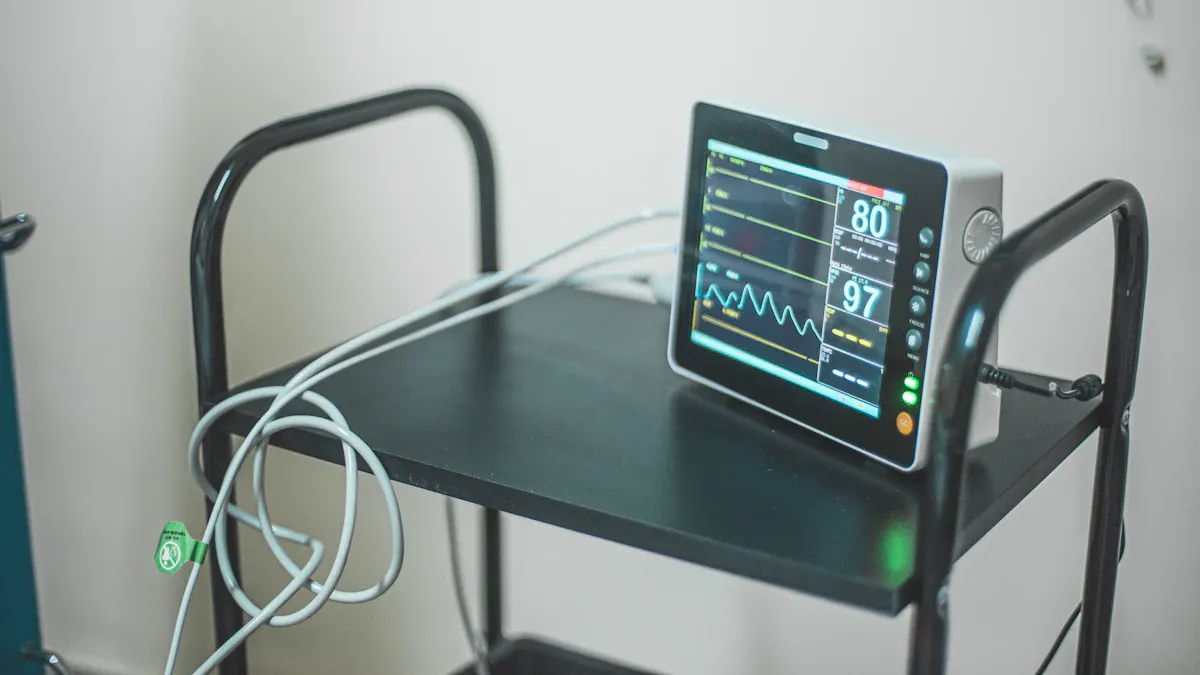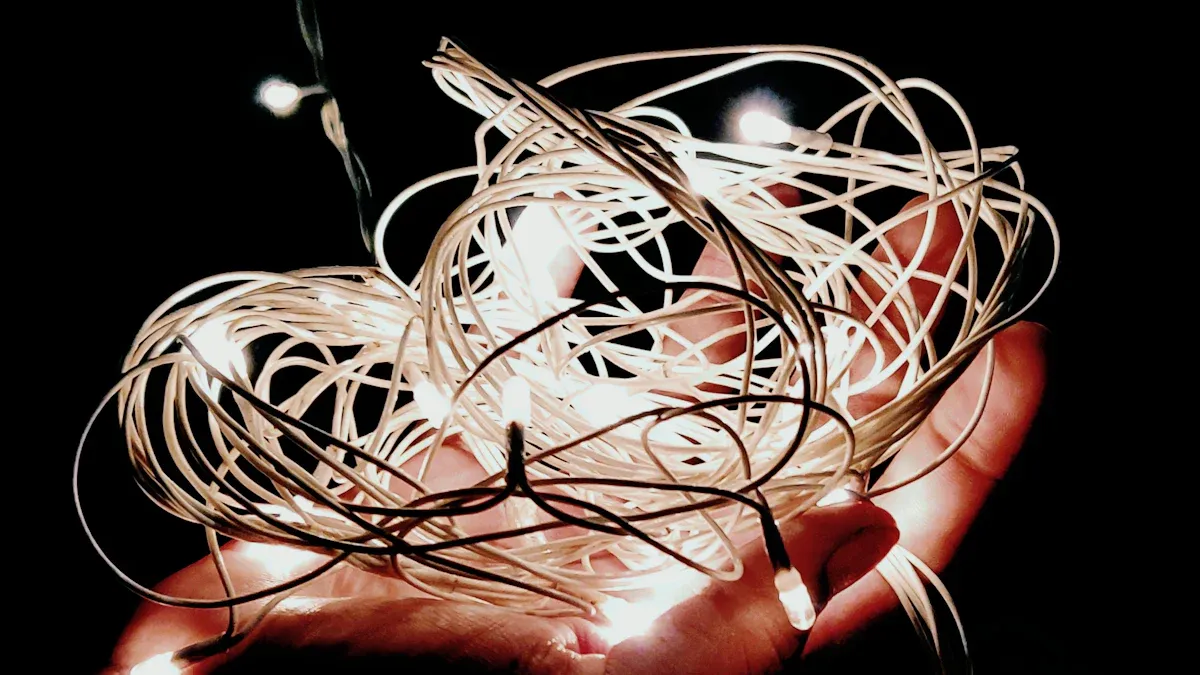What is PET Heat Shrink Tubing and How Does It Insulate Neurostimulator Leads

PET heat shrink tubing covers neurostimulator leads to keep them safe. PET heat shrink for neurostimulator lead insulation uses a thin and strong layer. This layer fits tightly around the wires. PET heat-shrink tubing can resist chemicals and protects the device. PET is special because its thin walls do not make things bulky. PET heat shrink tubing gives high protection and is safe for the body. PET heat shrink for neurostimulator lead insulation helps keep medical devices safe. PET heat shrink tubing and PET heat-shrink tubing work very well. PET gives good safety and stays flexible. PET heat shrink tubing is a trusted choice for medical use.
Key Takeaways
PET heat shrink tubing gives a strong and thin cover. It is also flexible. This layer helps keep neurostimulator leads safe. It makes sure they work well.
It does not get damaged by chemicals. It can handle heat and sterilization. This makes it good for use in the body for a long time.
The tubing stops electricity from leaking out. This keeps patients safe.
PET tubing has very thin walls. This helps medical devices stay small. It also keeps them comfortable. It does not make them heavy or stiff.
Safety tests are done on PET heat shrink tubing. It also gets approval from regulators. This shows it is a safe choice for protecting medical devices.
PET Heat Shrink Tubing Overview

What Is PET Heat Shrink Tubing
PET heat shrink tubing is a special tube made from PET. PET stands for polyethylene terephthalate. It forms when two chemicals join together. These chemicals are terephthalic acid and ethylene glycol. PET has ring groups in its structure. These rings make it strong and able to handle heat. PET melts at very high temperatures, between 225°C and 265°C. This makes it good for many jobs. PET is partly crystal-like, so it stays tough and clear. These things make PET a good pick for medical use. It works well when devices need to last and handle heat.
PET heat shrink tubing is known for being thin and able to shrink. The walls can be as thin as 0.0001 inches. The tubing can shrink to fit tightly around wires or parts. It shrinks across and along its length. The tubing can get up to 70% smaller in diameter but stays strong. Most PET heat shrink tubing comes in sizes from 0.006 inches to 0.5 inches wide. The tubing fits tightly, leaving almost no gap. This is important for medical-grade tubing.
PET heat shrink tubing is used in medical devices because it is strong and thin. It can shrink to fit tightly. It protects wires and parts inside devices. This helps them work safely and last longer.
PET heat-shrink tubing is also liked for medical use because it resists chemicals. It can be cleaned and sterilized without getting damaged. PET heat shrink for neurostimulator lead insulation uses these features. It keeps the leads safe and working well.
Key Features of PET Heat Shrink Tubing:
Thin walls (as thin as 0.0001")
High strength and durability
Shrinkage capability up to 70%
Wide range of diameters with tight tolerances
Chemical resistance and ability to withstand sterilization
How It Works
PET heat shrink tubing works by using heat and stretching. First, the tubing is treated with an electron accelerator. This step makes the tubing stronger and more stable. Next, the tubing is heated and stretched to make it bigger. After cooling, it keeps this bigger shape until it is used.
To use PET heat shrink tubing, you put it over the part you want to protect. Then you heat the tubing again. The heat makes the tubing shrink back to its original size. It wraps tightly around the object. This gives a smooth, tight fit that protects what is inside.
The tubing is made stronger with an electron accelerator.
It is stretched and cooled to keep its shape.
When used, the tubing is put over the part and heated.
The tubing shrinks to its original size and seals tightly.
Even heating and slow cooling stop bubbles and wrinkles.
PET heat shrink tubing is important for medical use. It is used in neurostimulator lead insulation. It gives a tight, protective layer that keeps the leads safe. The tubing can be sterilized, which is needed for devices inside the body. PET heat-shrink tubing helps neurostimulator leads stay flexible and reliable.
PET heat shrink for neurostimulator lead insulation uses these good features. The tubing does not add much size, so devices stay small and easy to use. PET heat shrink tubing is trusted for medical use. It is strong, flexible, and safe.
Properties and Electrical Insulation
PET heat shrink tubing is a great insulator for neurostimulator leads. It is strong and keeps wires safe from electrical problems. The tubing makes a tight barrier around the wires. This stops electricity from leaking out. It keeps the current inside and away from the body. These features make PET heat shrink tubing a good choice for safety.
Dielectric Strength
PET heat shrink tubing can handle high voltages. It does not break down easily. This is why it is used in electronics, cars, and healthcare. The tubing keeps electrical systems safe, even in tough places. It stops short circuits and helps neurostimulator leads work well. More people use PET heat shrink tubing in electric cars and new electronics. This shows that many trust its insulation. The market for PET heat shrink tubing is growing. People believe it gives good insulation and safety for important uses.
PET heat shrink tubing’s dielectric strength keeps neurostimulator leads safe, even with high voltages or tough conditions.
Flexibility and Thin Walls
PET heat shrink tubing has very thin walls and bends easily. Studies show the walls can be as thin as 0.0002 inches. This lets the tubing fit tightly on small wires. Shrink ratios like 1.2:1, 1.5:1, and 2:1 help the tubing fit many sizes. The tubing is strong, with a tensile strength of at least 30,000 PSI. It can bend without breaking. PET heat-shrink tubing fits many shapes and sizes. This makes it good for medical devices that need to be flexible and small.
Wall thickness is from 0.0002 to 0.008 inches for thin builds.
Shrink ratios up to 2:1 give tight fits.
Shrink temperatures are from 90°C to 240°C for many uses.
Tensile strength of at least 30,000 PSI means it is tough.
Inner diameters from 0.25 mm to 8.5 mm fit many parts.
The thin walls do not make neurostimulator leads bulky. This keeps the device flexible and comfy for patients. The tubing’s flexibility also helps stop damage when moving.
Chemical Resistance
PET heat shrink tubing resists chemicals very well. This makes it good for medical places. The tubing stands up to cleaners, disinfectants, oils, and water. It stays strong when near sodium carbonate and potassium carbonate. PET heat shrink tubing is also strong, with tensile strength over 107 N/m². It works in temperatures from -196°C to 135°C for a long time, and up to 200°C for short times.
Property/Environment | Performance Metric/Observation |
|---|---|
Chemical Resistance | Great resistance to cleaners, disinfectants, oils, and water |
Sodium Carbonate | Stays strong and keeps its shape |
Potassium Carbonate | Shows good chemical strength |
Tensile Strength | Very strong, over 107 N/m² (ASTM D2671 standard) |
Temperature Resistance | Long-term: -196°C to 135°C; Short-term: up to 200°C |
UV Stability | Stays stable in sunlight, does not break down |
Moisture Resistance | Keeps working in wet places |
Comparison to PVC Tubing | Better chemical resistance and handles more heat |
Comparison to Fluoropolymer | Fluoropolymer is stronger but costs more and is less clear |
Application Examples | Used in medical devices, car wiring, and factories |
PET heat shrink tubing also fights off scratches and water. These features protect neurostimulator leads from damage. The tubing does not break down in sunlight. PET heat-shrink tubing keeps working after many cleanings, which is important for medical safety.
PET heat shrink tubing’s chemical and moisture resistance help keep neurostimulator leads safe for a long time.
Benefits for Neurostimulator Lead Insulation

Mechanical Protection and Strain Relief
PET heat shrink for neurostimulator lead insulation keeps wires safe. The tubing covers the leads and protects them from bumps. It also helps stop damage when the device moves inside the body. The tubing holds the wires in place so they do not shift. It gives strain relief, which means less stress at wire connections. This lowers the chance of breaks or tears. The tubing does not wear out easily from rubbing. Medical devices need this protection to work well.
PET heat shrink tubing stops rubbing damage and keeps neurostimulator leads safe every day.
Durability and Device Performance
PET heat shrink tubing lasts a long time and is very tough. It does not get ruined by chemicals, water, or heat. This helps the device work well in hard places. The tubing also blocks unwanted electricity. This keeps the device and patient safe. PET heat shrink tubing protects wires from harm for a long time. Doctors and engineers trust it because it keeps neurostimulator leads working.
PET heat shrink tubing gives:
Strong resistance to chemicals and heat
Good electrical insulation
Long-lasting wire protection
Minimal Size Impact
PET heat shrink tubing has very thin walls. This keeps the device small and easy to move. The tubing does not make the neurostimulator bulky. It still gives strong electrical insulation even though it is slim. The tubing bends easily so the device moves with the body. Patients can wear it without feeling pain. The small size also helps doctors put the device in during surgery.
Thin PET heat shrink tubing makes the device comfy and helps it stay in place.
Biocompatibility and Safety
Biocompatibility in Medical Devices
Biocompatibility is very important for devices put in the body. Neurostimulator leads stay inside people for a long time. The materials used must not hurt the body or cause bad reactions. PET heat shrink tubing is good for medical use because it does not cause allergies or skin problems. This tubing stands up well to body fluids and chemicals. It keeps its shape and strength after being cleaned, which helps keep patients safe.
Doctors pick PET heat shrink tubing because it is safe and feels comfortable in the body.
It is also important that the tubing can be cleaned safely. PET tubing can handle cleaning with steam or gas and still protect the wires. This makes it a trusted choice for medical devices, where safety is very important.
Regulatory Compliance
Regulatory groups make strict rules for materials in neurostimulator leads. They want tests for safety, chemical strength, and how long the tubing lasts. These tests include:
Cytotoxicity: Scientists put cells on the tubing and see if the cells live.
Sensitization and irritation: Experts check for allergies or skin problems.
Systemic toxicity: They test if the tubing hurts the whole body.
Corrosion resistance: The tubing sits in salty water at body heat to see if it breaks down.
Electrical safety: Engineers check how well the tubing stops unwanted electricity.
Rules like ANSI/AAMI CI86:2017 list tests for charge limits, heat safety, and strength. Agencies use special tools to check for leaks and if wires affect each other. They also look for metal ions and changes on the surface to make sure the tubing stays safe for a long time.
Regulators want device makers to talk to them early. This helps plan the right tests for new materials or designs. PET heat shrink tubing passes these tough rules, so it is a good choice for medical use.
PET Heat Shrink vs. Alternatives
Comparison with Other Materials
There are many ways to cover neurostimulator leads. PET heat shrink tubing, silicone, polyolefin, and PTFE are all used. Each one has good and bad points. The table below shows how they compare in different ways:
Feature / Metric | PET Heat Shrink Tubing | Silicone Tubing | Polyolefin Tubing | PTFE Tubing |
|---|---|---|---|---|
Tensile Strength | Strong | Weaker | N/A | Less strong |
Durability | Long-lasting | Average | N/A | Lasts long |
Structural Integrity | Excellent | Okay | N/A | Less sturdy |
Flexibility | Moderate | High | N/A | Bends easily |
Weight Savings | Significant | N/A | N/A | N/A |
Dielectric Strength | >600 V/mil | Lower | >600 V/mil | Good |
Tensile Strength Retention | 98% after 2000 uses | N/A | N/A | N/A |
Wall Thickness | <0.1 mm | N/A | N/A | N/A |
Moisture Absorption Rate | <0.3% | N/A | N/A | N/A |
Heat Resistance | Up to 150°C | Lower | Moderate | Up to 200°C |
Chemical Resistance | Good (oils) | Moderate | Moderate | Excellent |
Cost | Cost-effective | N/A | N/A | More costly |
PET heat shrink tubing is very strong and lasts a long time. It keeps its shape even after many uses. Silicone tubing bends more but does not last as long. PTFE tubing is better with chemicals and heat but costs more money. Polyolefin tubing works for some jobs but is not as strong or tough as PET.
PET heat shrink tubing is not too thick or heavy. This helps it protect wires without making devices big. Some other materials, like wool blends, can block sound or heat better. But they do not keep electricity safe or save space like PET.
Why PET Is Preferred
PET heat shrink tubing is the best pick for covering neurostimulator leads. It gives many important benefits:
Keeps working in very hot or cold places, even during cleaning.
Stops electricity from leaking, which keeps people safe.
Stays strong against harsh cleaners used in hospitals.
Bends enough to fit many wire shapes and sizes.
Lasts a long time, so you do not need to fix or change it often.
PET heat-shrink tubing also saves money. It costs less than PTFE and lasts longer than silicone. PET can be recycled, which is good for the planet. In hospitals, PET heat shrink tubing keeps wires safe and helps devices work well. Its thin walls keep devices small and comfy.
PET heat shrink tubing is strong, safe, and a good value. That is why it is the top choice for neurostimulator lead insulation.
PET heat shrink tubing helps keep neurostimulator leads safe. The walls are strong and thin, so devices last longer. PET tubing bends easily and helps devices work well. It keeps patients safe and follows tough medical rules.
PET tubing is very strong and lasts a long time.
It does not get damaged by sunlight or water.
PET can be recycled and is good for the environment.
Many businesses pick PET because it protects things well.
PET heat shrink tubing will help make new medical devices in the future.
FAQ
What makes PET heat shrink tubing different from other tubing?
PET heat shrink tubing uses very thin walls and strong material. It shrinks tightly around wires. This tubing resists chemicals and heat better than many other types. Doctors and engineers trust PET for medical devices.
Can PET heat shrink tubing be sterilized?
Yes, PET heat shrink tubing can handle steam or gas sterilization. It stays strong and keeps its shape after cleaning. This makes it safe for use in medical devices that go inside the body.
How does PET heat shrink tubing protect neurostimulator leads?
PET heat shrink tubing covers the leads with a tight, strong layer. This layer blocks water, chemicals, and electricity. It also helps the wires bend without breaking. The tubing keeps the device working safely.
Is PET heat shrink tubing safe for long-term use in the body?
Doctors use PET heat shrink tubing because it does not cause allergies or skin problems. It passes strict safety tests. The tubing stays strong and safe for many years inside the body.
What sizes does PET heat shrink tubing come in?
PET heat shrink tubing comes in many sizes. Diameters range from 0.006 inches to 0.5 inches. The tubing can shrink up to 70% to fit tightly around different wires and parts.
Tip: Always choose the right size of PET heat shrink tubing for the best protection and fit.

